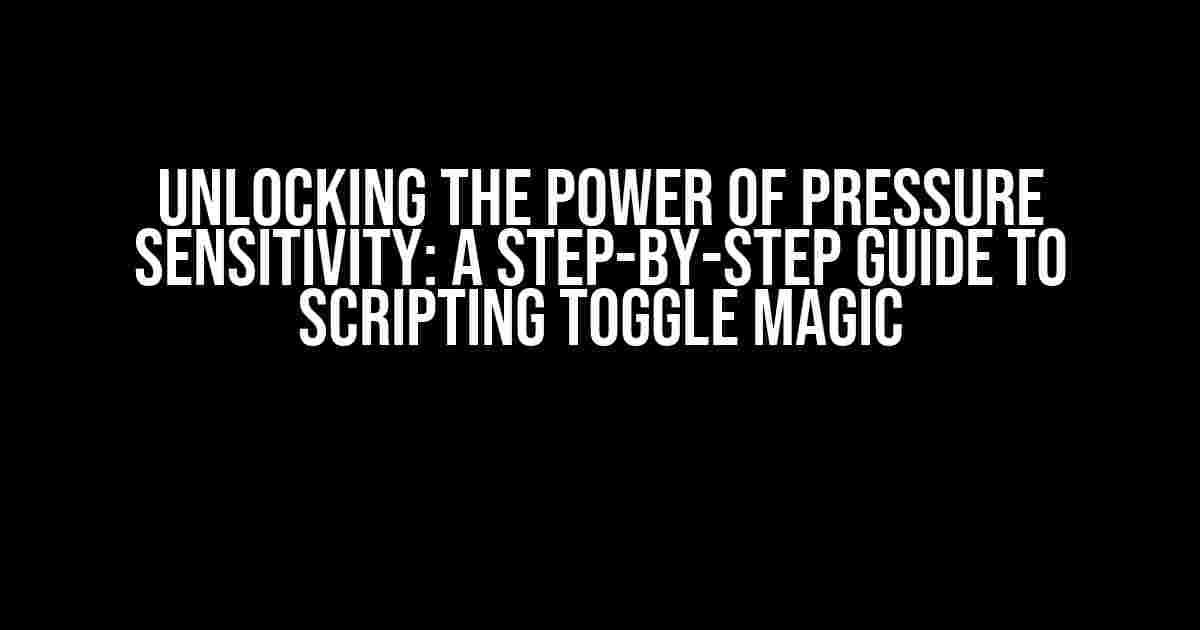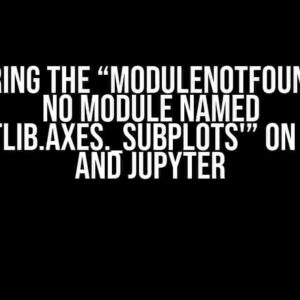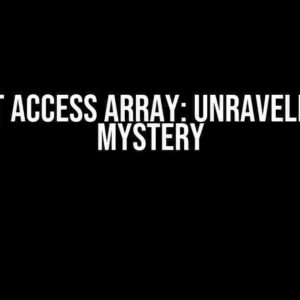Welcome, fellow creatives and tech enthusiasts! Are you tired of feeling limited by your stylus or digital drawing tool’s lack of pressure sensitivity? Do you yearn for the freedom to express yourself with precision and finesse? Look no further! In this comprehensive guide, we’ll delve into the world of scripting and unveil the secrets to toggling pressure sensitivity with ease.
What is Pressure Sensitivity, and Why Do I Need It?
Pressure sensitivity is the ability of a stylus or digital drawing tool to detect and respond to varying levels of pressure applied by the user. This feature allows artists, designers, and writers to create more nuanced and expressive work, with subtle variations in line weight, opacity, and texture. Without pressure sensitivity, digital art can often appear stiff and lacking in character.
Built-in Support vs. Scripting: What’s the Difference?
Some devices and applications come with built-in pressure sensitivity support. However, this support can be limited, and the range of sensitivity might not be sufficient for your creative needs. That’s where scripting comes in – by writing custom scripts, you can unlock the full potential of your stylus or digital drawing tool, gaining greater control over pressure sensitivity and achieving the precise results you desire.
Toggling Pressure Sensitivity: Scripting 101
Before we dive into the script itself, let’s set the stage by covering the basics of scripting. Don’t worry if you’re new to coding; we’ll take it one step at a time!
Choosing the Right Scripting Language
// A simple JavaScript alert to get you started
alert("Hello, world!");
Understanding the Pressure Sensitivity Script
The script we’ll be working with is designed to toggle pressure sensitivity on and off, allowing you to adapt to different creative scenarios. We’ll break it down into smaller sections, making it easy to follow along.
// Pressure Sensitivity Toggle Script
function togglePressureSensitivity() {
// Get the current state of pressure sensitivity
var currentState = getPressureSensitivityState();
// Toggle the state
if (currentState === true) {
setPressureSensitivityState(false);
} else {
setPressureSensitivityState(true);
}
}
// Function to get the current pressure sensitivity state
function getPressureSensitivityState() {
// Return true if pressure sensitivity is enabled, false otherwise
return true; // Replace with your device/application's API call
}
// Function to set the pressure sensitivity state
function setPressureSensitivityState(state) {
// Set the pressure sensitivity state to the specified value
// Replace with your device/application's API call
alert("Pressure sensitivity " + (state ? "enabled" : "disabled"));
}
Integrating the Script with Your Device or Application
Now that we have the script, it’s time to integrate it with your device or application. This might require some research on your part, as the specific implementation will depend on the device or application you’re using.
For example, if you’re using a Wacom tablet, you might need to use the Wacom API to access the pressure sensitivity settings. Consult your device or application’s documentation for more information.
| Device/Application | API Call |
|---|---|
| Wacom Tablet | wacom.getPressureSensitivityEnabled() |
| Adobe Photoshop | app.preferences.pressureSensitivityEnabled |
| Windows 10 | window.localStorage.pressureSensitivityEnabled |
Tips, Tricks, and Variations
Assigning the Script to a Hotkey
To make the script more accessible, consider assigning it to a hotkey or shortcut. This will allow you to toggle pressure sensitivity quickly and easily, without interrupting your creative flow.
- Open your device or application’s settings or preferences.
- Look for the hotkey or shortcut settings.
- Assign the script to a desired hotkey (e.g., F1, Ctrl + Shift + P, etc.).
Customizing the Script for Specific Use Cases
The script we’ve created is designed to be flexible and adaptable. Feel free to modify it to suit your specific needs!
- Reverse the toggle behavior: Change the script to enable pressure sensitivity by default, and disable it when the hotkey is pressed.
- Add a visual indicator: Use CSS to create a visual indicator (e.g., a button or icon) that shows the current state of pressure sensitivity.
- Integrate with other scripts: Combine this script with others to create a custom workflow that streamlines your creative process.
Troubleshooting Common Issues
As with any script, you might encounter issues or errors. Don’t panic! Here are some common problems and their solutions:
| Issue | Solution |
|---|---|
| Script not working | Check the script syntax and API calls for errors. Ensure the script is properly integrated with your device or application. |
| Pressure sensitivity not toggling | Verify that the script is correctly assigning the pressure sensitivity state. Check the device or application’s documentation for specific implementation details. |
| Hotkey not responding | Check the hotkey settings and ensure the script is correctly assigned to the desired key. Restart your device or application if necessary. |
Conclusion: Unlocking the Full Potential of Pressure Sensitivity
With this comprehensive guide, you now possess the knowledge and tools to unlock the full potential of pressure sensitivity. By scripting a toggle feature, you’ll be able to adapt to different creative scenarios, enhance your workflow, and bring your digital art to life.
Remember, practice makes perfect. Experiment with the script, customize it to your needs, and don’t be afraid to push the boundaries of what’s possible. Happy creating!
Stay tuned for more tutorials, guides, and insights into the world of scripting and digital art. If you have any questions or need further assistance, feel free to ask in the comments below.
Frequently Asked Question
Get the scoop on scripting pressure sensitivity toggle, and take your digital art to the next level!
What is a script to toggle pressure sensitivity, and why do I need it?
A script to toggle pressure sensitivity is a tiny piece of code that lets you switch between pressure-sensitive and non-pressure-sensitive drawing modes on the fly! You need it because it saves you time and effort when working on digital art, allowing you to focus on your creative vision rather than tedious menu-hopping.
How do I write a script to toggle pressure sensitivity in Adobe Photoshop?
Easy peasy! In Adobe Photoshop, you can write a script using the Script Editor or an external editor like Notepad++. Simply create a new document, add the following code: var Photoshop = new PhotoshopDocument( 'YourDocument' ); Photoshop.setPressureSensitivity( !Photoshop.pressureSensitivity );, and save it as a JavaScript file (.jsx). Then, assign a shortcut to the script in Edit > Keyboard Shortcuts, and you’re good to go!
Can I use a script to toggle pressure sensitivity in other digital art software?
Absolutely! While the script may vary depending on the software, you can toggle pressure sensitivity in other popular digital art tools like Illustrator, Sketchbook Pro, or even Blender. Just research the specific script language and syntax for your software, and get creative!
Are there any shortcuts or workarounds if I don’t know how to script?
Don’t worry, script-phobes! If you’re not comfortable with coding, you can try using a pressure-sensitive toggle button in your Wacom tablet settings or use a third-party plugin that offers a toggle feature. Alternatively, you can ask a friend who’s handy with scripts to help you out or search for pre-made scripts online.
What are some benefits of using a script to toggle pressure sensitivity?
The benefits are endless! With a script, you’ll save time, increase productivity, and reduce menu-clicking fatigue. You’ll also gain more creative control, as you can quickly switch between precise lines and expressive brushstrokes. Plus, it’s a great way to streamline your workflow and focus on bringing your artistic vision to life!




